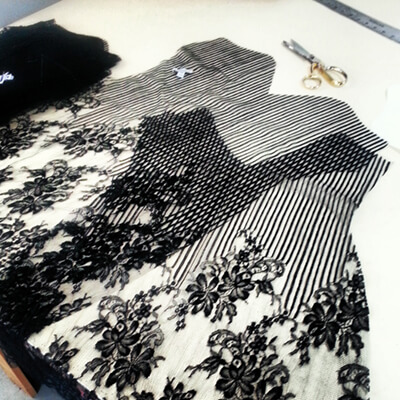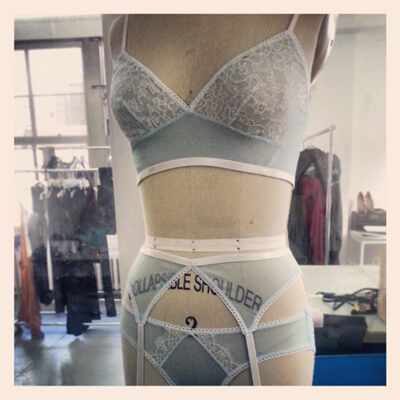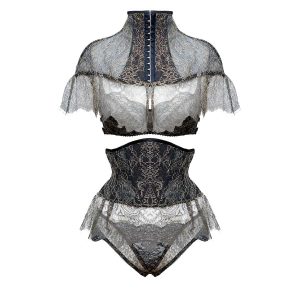The Real Value of Handmade Lingerie: Part I - Direct Costs
This guest post is by Angela Friedman, independent lingerie designer and all around awesome lady behind Angela Friedman Lingerie. This two-part series will explore the real costs of handmade lingerie, as well as the true costs of running a handmade lingerie business.
Believe it or not, every garment you're wearing right now (or have ever worn, for that matter), was made by a pair of hands. Or several pairs of hands. But there are no magical machines that take in a bolt of fabric and spit out a robe! There are sewing machines but there are no sewing machine robots. So this leads to the ultimate question... Who made your lingerie? Don't worry, I won't begin a guilt-ridden tirade on sweatshops overseas, on underpaid and overworked laborers – we've all read the news headlines about conditions in factories overseas. We all know the true “price” of our fast fashion clothing.
But why then, are independent designers constantly asked, “Why are your designs so expensive?” At first, it was difficult for me to not take offense at the notion. It was never an attack on me personally, on the quality of my products, or on my moral integrity as a price-decider! But what I quickly realized was that people actually didn't know. In our modern world of technology, we have become completely removed from basic processes like building a house, growing food, and sewing clothing. People genuinely have no idea what time, effort, and money it costs to create a piece of clothing from start to finish.
First, a caveat: I'm an independent designer, and this is my experience. The process may be somewhat different for other designers, and certainly so for mass-market brands and clothing produced overseas. This is the experience of a small business, made in America. Here are the facts and figures at Angela Friedman, Inc.
Direct Costs
When you consider the price of a garment, you're probably thinking about fabric and sewing. You understand that luxury materials cost more and that complicated designs take more time to produce. But there are more factors at stake: For example, independent designers also tend to be more open to experimenting with high-end materials, because they aren't bound by the limitations of a number-cruncher yelling “cheaper, cheaper, cheaper!” (I challenge you to find metallic French lace in the lingerie at your local mall!) Something else to consider is that fabric cost can pose a scaling problem: If I were a mass-market brand purchasing 5,000 meters of silk at a time, I would have a lot more negotiating power than I do with my limited resources. Of course I purchase in bulk whenever possible, but I don't always have the capital or the orders to justify an enormous expenditure up-front. That's just the reality of small business.
Now someone actually has to create the garments. This is where I wish we had those sewing machine robots! It isn't as simple as it sounds: There is expensive machinery needed, many different people are involved in the process, and sewing lingerie can be very time-consuming. Some of my designs have literally dozens of pattern pieces, and each pattern piece must be sized properly, cut out of however many layers of fabric are used, sewn together, pressed neatly, and have edges finished and trimmings applied. This can quickly turn into many hours of labor, whether being performed by one seamstress or done in a factory, production-line style. This also brings us to the importance of ethical business practices. I can choose to pay a local seamstress a living wage, or I can choose to send the job overseas where I have little to no control over who does the work, how much (or how little) they may be paid, or what their work conditions consist of. (I choose to do all of my production in New York.)
Here are just some of the direct costs that go into the production of a single garment:
-fabric, linings, and hardware (like bra hook-and-eye and garter clips)
-elastic and thread
-custom labels and hang tags
-labor for drafting patterns, scaling them to each size, and testing the fit (on a live model!)
-labor for cutting fabric
-labor for sewing pieces together, applying elastic, hemming, sewing labels, etc.
-labor for quality control, packaging, and shipping
It's pretty obvious how these direct costs end up in the final price of the garment. For my bra and panty sets, this section would already be in the $35-$50 range. Given those numbers, now you can start to see why I couldn't possibly sell a set for $50! More expensive materials (like silk or dyed-to-match trimmings) produce a more valuable garment. The same is true with production: Seamstresses generally charge based on an hourly rate, but their wages will amount to less than 1/8th of your final purchase price – at best. This is for American production. Just think of how much less a worker might be making in China, India, or Bangladesh.











